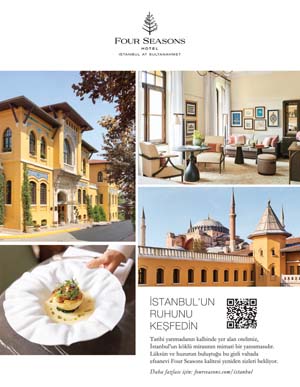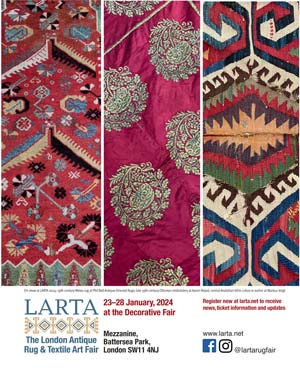On September 4 I attended a concert at the Cemal Reşit Rey Concert Hall in Harbiye – one of the events of the 3rd Istanbul International Chamber Music Festival, held at this venue. My ticket, which allowed me to sit in the centre of the auditorium and as close to the stage as I wished to be, was extremely cheap: less than four dollars or three pounds sterling. I must therefore express my gratitude to the Greater Municipality of Istanbul for their generosity and thoughtfulness in making high-quality music available to the Istanbul public at such a low cost.
This was one of those concerts where the second half is quite different from the first. In the first we heard a string quartet by the name of Les Essences that represents the core of a larger chamber orchestra based in North Rhine-Westphalia. (In fact, the word ‘Essences’ is a play on ‘Essen’ – the name of the city from which they originate.) Although Les Essences does not have a conductor, it has an artistic and musical director in the shape of Önder Baloğlu, a German-Turkish violinist. Mr Baloğlu was not present on this occasion; however, in the second half the string players were joined by the 73-year-old pianist Pavel Gililov.
The proceedings began with a performance of Crisantemi (‘Chrysanthemums’), a string quartet by Puccini (1858–1924). Crisantemi was composed in 1890 – reputedly in a single night, after Puccini had heard the news of the death of his friend the Duke of Aosta, a member of the House of Savoy who was the second son of King Victor Emmanuel II of Italy. Twenty years previously the Duke (then 25) had become King Amadeo I of Spain; after three years, however, he had returned to Italy, having declared the Spanish people ‘ungovernable’. The events surrounding this work’s composition are described in uncomplicated terms on the ‘Musical Musings’ website. It says ‘Posted by Alan Beggerow’ at the bottom, so I presume Mr Beggerow is the author.
Here is a performance of Crisantemi by the Ysaÿe Quartet, a French outfit that ran from 1984 until 2014 and was named after the original Ysaÿe Quartet, which was founded in 1886 by the celebrated Belgian violinist Eugène Ysaÿe.
This piece is admittedly an elegy, but the performance by Les Essences was so quiet that although I was sitting fairly near the front I could hardly hear what was transpiring on the stage. The viola was very faint and the cello all but inaudible. Maybe the microphones dangling from the ceiling were not picking things up satisfactorily, or maybe the players were not feeling particularly communicative after being bashed around in a tin box (ie an aeroplane) for two or three hours. However, the emotional impact of the piece was considerably dampened by its failure to come across to all but those sitting in the front rows.
On the subject of Puccini, I would like (in the hope that this humorous aside will not be considered out of place) to recall a scene from one of the Wallace & Gromit ‘claymation’ films that appeared on British television in 1989. In Wallace’s car there was a selection of CDs designed to appeal to the tastes of Gromit, his faithful and long-suffering dog. Two of them were entitled The Hound of Music and Poochini.
Back to the concert. Thankfully, things picked up in the second item – Samuel Barber’s three-movement String Quartet in B minor, written in 1935–36. The composer subsequently arranged the middle movement of this work under the title Adagio for Strings. To my mind, this is the only genuinely great piece of classical music ever to have come out of the United States.
But let me expand on this somewhat bold statement. I confess that I am not an admirer of the work of Aaron Copland, whose borrowings from Bartók do not impress me. Copland took the open fourths and fifths that are a feature of Hungarian and Transylvanian folk music and ran with them, but I fear the result displays too much primitivism and too little musical sensitivity. I am, however, a fan of the music of Charles Ives, whom I regard as an important innovator and pioneer of modernism whose works are underrated. This being said, Ives never produced anything with even a fraction of the emotional impact of Barber’s Adagio. As for George Gershwin (real name ‘Jacob Gershwine’, born to Jewish parents who had emigrated from Odessa), he is a composer for whose skills as a melodist and orchestrator I have the highest respect. Thanks to the blood in his veins I see him – rightly or wrongly – as a product of the Russian Jewish cultural tradition. One wonders how much the opening clarinet solo of his Rhapsody in Blue owes to the Jewish Klezmer tradition. (Here is a link to the Wikipedia entry for Klezmer. Unsurprisingly, it lists Ottoman, Greek and Romanian music as influences.) But that is just my own personal view: I cannot dispute the fact that Gershwin spent most of his childhood not in Odessa but in the Yiddish Theatre District of New York City.
Anyway, back to Samuel Barber. The Encyclopedia Britannica sums up his style very neatly:
‘Samuel Barber... is considered one of the most expressive representatives of the lyric and Romantic trends in 20th-century classical music. ... His style was distinctive and modern but not experimental. ... Structural considerations govern Barber’s instrumental writing; there is great astringency in harmony, but the basic tonality remains secure; the rhythmic lines are very strong, without loss of coherence.’
And indeed, the first and third movements of his String Quartet display a great deal of ‘astringency’, sticking the listener with a good many atonal barbs. (Honestly, that last word was not intended as a pun on the composer’s surname. Honestly!) I have looked through his biography in an attempt to find a reason why he should have felt intensely emotional at the time when he wrote this work, but have found none. The break-up with his long-term partner Gian Carlo Menotti (who was, like him, a composer) took place many years later, in 1970. Indeed, in 1935 and 1936 things ought to have been going swimmingly for Barber. He had been taken up by Mary Curtis Bok, founder of the Curtis Institute (where both he and Menotti had been students). She proved an exceptionally loyal patroness, promoting his work and even helping him and Menotti buy a house for themselves – ‘Capricorn’, in Mount Kisco, New York.
If the truth be told, the only reason I can find for the strong emotional appeal that the second movement of the Quartet undoubtedly has, and that has ensured lasting fame for its creator both in the USA and abroad, is that he was a hypersensitive – and thus exceptionally vulnerable – Pisces. In fact, positives greatly outnumber negatives in his birth chart. For one thing, Jupiter, the ruler of his sanguine Sagittarian Ascendant, is in Libra, making an easy-going trine to his warm, friendly and artistic Moon-Venus conjunction in Aquarius. For another, the Sun is forming a harmonious trine aspect to Neptune, the planet of music and ... wait for it ... alcohol. (Neptune, though stimulating to the imagination, can induce self-doubt and depression.) Perhaps that was the fly in the proverbial ointment: Samuel Barber died of drink.
The following performance of his String Quartet in B minor is by the Auner Quartet.
I cannot leave the subject of Samuel Barber without drawing attention to his darker side. Here is his Piano Sonata in E flat minor with its tone rows, its spiky discords (who said he was a musically conservative lyricist?) and its chilling third movement, which starts at 8:57. This piece is definitely not the sort of thing to play at a children’s party, or at a wedding reception. If obliged to wait for hours in driving sleet outside a slaughterhouse for a bus that does not come, however, it might well match your mood. The first performance, in 1949, was by the legendary pianist Vladimir Horowitz. Indeed, only a virtuoso could hope to negotiate the fearsome fourth movement (scroll on to 14:21 for this) with any chance of success.
As previously stated, the second half of the concert at the Cemal Reşit Rey Concert Hall was radically different from the first, the reason being that the string players (minus the second violin) were now joined by a seasoned top-rank pianist in the shape of Pavel Gililov. Born in Donetsk in 1950, Mr Gililov won the National Piano Competition in Moscow while still a student at the Leningrad Conservatory, later coming first in the International Chopin Competition in Warsaw. Having emigrated to the West in 1978, he served as a professor at the Cologne University of Music from 1979 to 2013, and is currently Professor of Piano at the Mozarteum University Salzburg.
The whole of the second half consisted of one work: Johannes Brahms’s four-movement Piano Quartet No 1 in G minor, written between 1856 and 1861. (This one is quite a tour de force, and usually takes between 38 and 42 minutes to perform.) The Wikipedia entry gives a fairly detailed analysis of each movement.
https://en.wikipedia.org/wiki/Piano_Quartet_No._1_(Brahms)
In his piece on the ‘earsense’ website, meanwhile, Kal Christiansen plays up the Hungarian and gypsy aspects of the work. Nevertheless, he fills in some important background information and makes some telling points.
This is high Romanticism par excellence. In my opinion an ideal performance would have a liberal number of potted palms gracing the stage. Especially in later life, Brahms patronised the spa town of Bad Ischl (in Upper Austria), and it was there that in 1882 he wrote his String Quintet No 1. I feel that, at the very least, black-and-white photographs of this resort’s elegant salons and dining rooms should be projected onto a screen while his chamber music is being played.
The following performance of Brahms’s Piano Quartet No 1 in G minor is by the Fauré Quartet.
During the second minute of the performance at the Cemal Reşit Rey Concert Hall, a cat walked onto the stage. After executing the expected washing procedures, it sauntered off behind the curtains, only to reappear briefly a few minutes later. I took its appearance as a token of feline approbation – and I myself fully endorsed the positive judgement: an excellent balance between pianist and string players, as well as flawless co-ordination, were maintained throughout, and I especially appreciated the rich tone the violist and cellist now showed themselves able to produce. The ending of the second movement was beautifully graceful, and the changes of tempo in the third were managed without the slightest hitch. (The pianist was invariably considerate, never allowing himself any excessive rubato that might have thrown his fellow-musicians off the beat.) In the last movement the bucolic dance – and here, let us remember that Brahms was a son-of-the-soil Taurus – was an exhilarating rhythmic treat.
If all the players excelled themselves in this piece, a large part of the responsibility for their success must go to the professionalism and long experience of pianist Pavel Gililov. Here he is accompanying cellist Mischa Maisky in Rachmaninov’s Vocalise. (This year, by the way, is the 150th anniversary of Rachmaninov’s birth.)Notice how perfectly Gililov mirrors every nuance the cellist brings to the piece, waiting for Maisky to come in every time he pauses before playing a note and slowing down with him seamlessly whenever he indulges in a spot of heartstring-tweaking.
All in all, this concert was a most rewarding one. Having got off to a rather slow start, it picked up in the second half. The listener was whirled round and round to the accompaniment of gypsy violins shimmering and swooping the night away. But while you are gyrating around the dance floor to the accompaniment of the intoxicating last movement of Brahms’s Piano Quartet No 1, make sure you do not knock over the potted palms.







